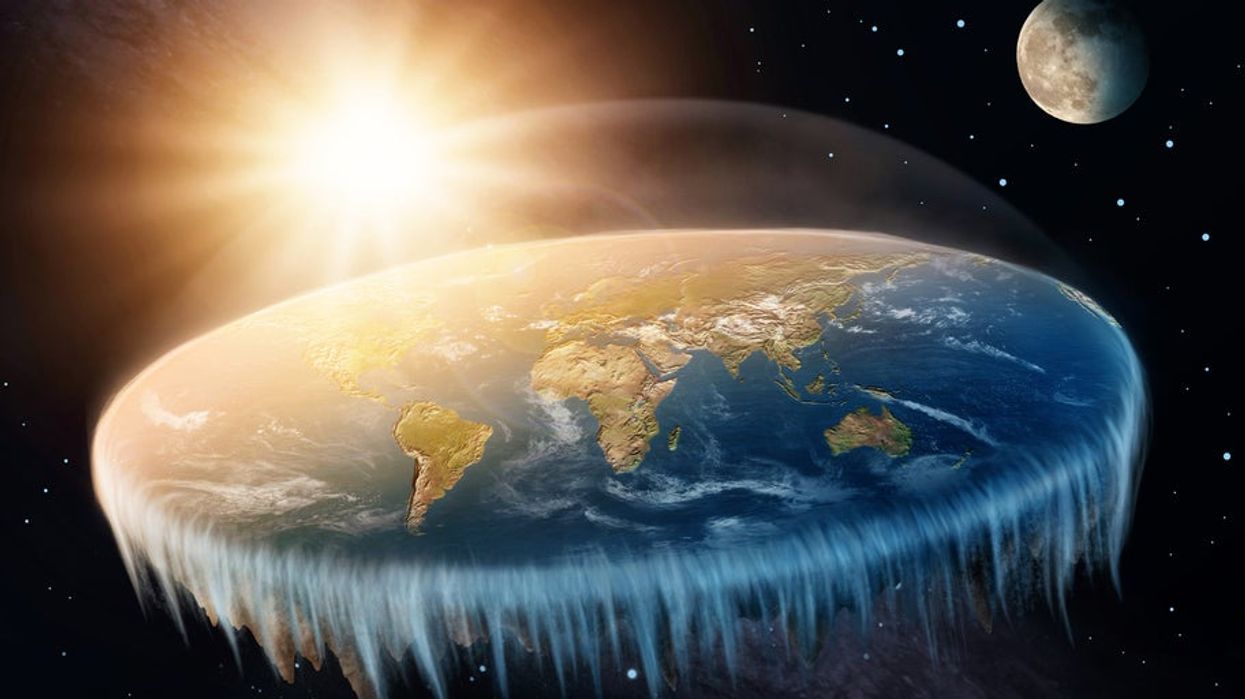Viral
Greg Evans
Nov 09, 2018

Picture:
Getty Images/iStock
You know all those times that we have laughed at Flat Earthers for their completely unfounded statements? Well, we've got a new one for you which will make Flat Earthers look like scientific geniuses.
Way back in 2012, a flat Earther on the infamous Flat Earth Society forum posted a mind-boggling theory that the Earth isn't round, nor is it flat, it is actually a doughnut shape. Yes, really.
The user, going by the name of Varuag, suggested this unfathomable theory after what seemed like an extended period of intense thinking.
They wrote:
I was wondering how a theory like FE theory gets formed, and I came to the conclusion that someone must've thought of the original idea, and then it must've been followed by a long series of people pointing out flaws and then re-adjusting the theory (or thinking of new ideas) to iron out the flaws in the theory.
So, I thought it might be fun if we emulated that here.
I will state my theory, and then we can adjust it by pointing out flaws and seeing if we can think of arguments that will counteract these flaws.
I have a theory that the Earth is in fact shaped like a torus (a donut-shape). However, light is curved so we cannot tell.
Perhaps anticipating that he would get a series of questions asking just how a planet could operate like this and have nobody ever notice that something was up, Varaug prepared a series of FAQ.
There are 11 of these so bear with us.
The first question asks why nobody has ever discovered the supposed hole that is in the centre of the Earth.
Light bends and follows the curvature of the torus, making the hole 'unseeable'.
OK, with that in mind it's worth asking why anyone would believe the earth is shaped in such a manner if light is actually curved.
Logically, it is possible for a torus-shaped planet to form, so we cannot rule out the possibility that the Earth is shaped like a torus, and therefore the hypothesis must be considered as a potential model.
So, just how does light manage to curve?
Radio waves are reflected by the atmosphere (hence why we don't need to set up several towers to transmit radio waves across very long distances).
Light waves are also reflected in a similar way. When we look across, the light diminishes as it travels, and by the time it reaches the atmosphere, it is diminished enough to be reflected.
The light will then hit another corner of atmosphere and so on and so forth, curving every time. This gives the impression that the Earth is flat (or has a slight curvature).
We are already seeing a lot of flaws in this theory, but let's just consider why we can always see the sky when we look up and not the other side of the planet?
When you look up, you are decreasing the amount of distance the light travels to reach the atmosphere, so it diminishes less.
In these cases, it is not diminished enough to be reflected by the atmosphere, and hence we can see the stars.
When you stand in the middle of the TE and look up, the light passes through the first atmosphere it reaches.
However, by the time it reaches the second atmosphere (the one to re-enter the atmosphere of the TE) it has diminished enough to be reflected and gets reflected into space, so you see space.
A classic question related to any Flat Earth theory is why no one has ever fallen off the side of the planet.
Gravity acts as it does in a RE model, and people are attracted to large masses.
Imagine a donut. Imagine a jam donut. Gravity acts towards the jam.
The concept of night and day would also be interesting. How would you experience any kind of night and day if you were in the inside of the hole?
This can apparently be easily explained with a torch and a table.
Lay a torch horizontal on a table and turn it on. Now, get a donut and place it on it's side, with the hole perpendicular to the torch.
The side that is illuminated by the torch is in day. Over 24 hours, the donut performs one complete revolution.
Spin it half way around, this signifies the passing of 12 hours. Now, the side that WAS in day, is facing away from the torch and is in night.
The side that WAS in night, is now facing the torch and is in day.
OK, OK. What about the seasons? How do they work?
In the same way that the RE does. The Earth does not follow a perfectly circular orbit, it is slightly elliptical.
Also, the ellipse is slightly shifted so that one of the shorter edges is closer to the Sun than the opposite edge.
Over 1 year, it completes one orbit. Say the Earth starts on the short side closest to the Sun.
This is summer (the hottest season for obvious reasons). 3 months later (one quarter of an orbit) it goes to one of the longer sides, and is slightly further away, entering autumn.
Another 3 months and it is at the point where it is furthest away, in the middle of winter.
Another 3 months and it's a bit closer and we're in spring. A further 3 months and we're back where we started!
We know full well that Flat Earthers are willing to accept that other planets are round and won't accept that the Earth is also spherical because they haven't seen any evidence.
How does Varaug explain that the doughnut Earth was formed then?
It is possible for two objects to orbit each other (google binary stars).
This means that you have two objects moving around in an orbit, but there is nothing in the centre of the orbit (as their own masses provide the weight for the centripetal force of Gravity, which causes them to move in a circular-ish motion.
Now, it is also possible to have 3 objects orbiting each other, or 4, or 5 etc. Now, the TE was formed when a large amount of objects orbited each other like this.
As time went on, their gravity pulled in more space rocks and dust etc and the shape grew, eventually becoming a fully-formed torus.
Varaug also came up with a reason for why there are no other doughnut planets.
This is because the condition for a TE to form (several objects orbiting each other rather than a large mass in the middle) is quite unlikely to occur, and becomes much more unlikely each time more objects are required in the orbit.
This makes torus-shaped planets very rare, and so far we are yet to discover another one
He also came up with an explanation for the north and south pole which might be the most flimsy excuse we have ever heard.
Place your donut on it's side. The side that touches the table is the south pole, the side on the other side is the north pole.
Considering that all of this was written seven years ago, it's safe to say that this theory hasn't caught on whatsoever with Flat Earthers.
There is the possibility that this is one big joke but it's safe to say that it has given us a headache and we're in need of a long lie down to collect our thoughts.
HT UniLad
More: This man just destroyed the Flat Earth theory with a basketball and a camera

Top 100
The Conversation (0)












